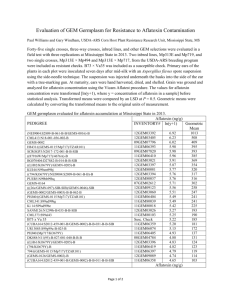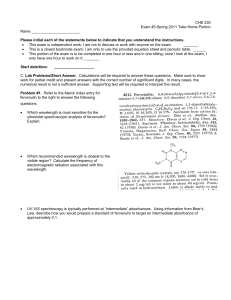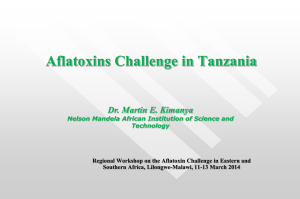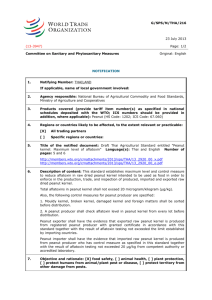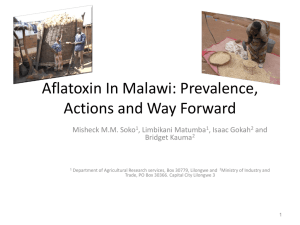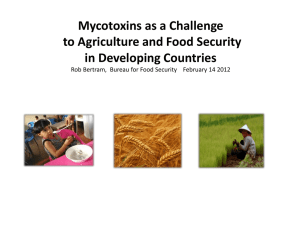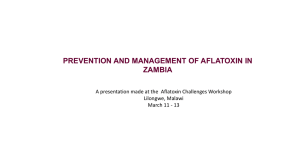Group Comparisons Part 1
advertisement
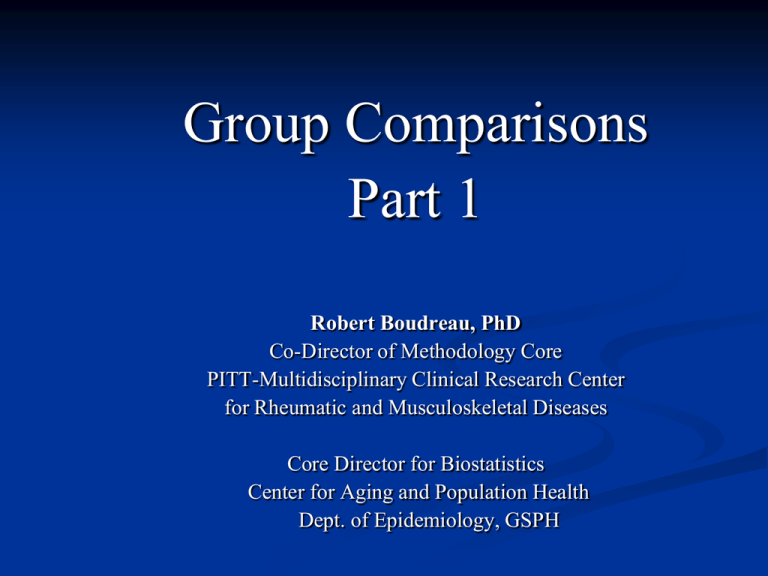
Group Comparisons Part 1 Robert Boudreau, PhD Co-Director of Methodology Core PITT-Multidisciplinary Clinical Research Center for Rheumatic and Musculoskeletal Diseases Core Director for Biostatistics Center for Aging and Population Health Dept. of Epidemiology, GSPH Flow chart for group comparisons Measurements to be compared continuous discrete ( binary, nominal, ordinal with few values) Distribution approx normal or N ≥ 20? No Yes Non-parametrics T-tests < next lecture > Outline For Today Continuous Distributions Normal distribution Mean Standard deviation ( computation, interpretation ) Confidence Intervals, t-distribution Comparing 2-groups T-tests Next lecture Wilcoxon Rank-Sum (non-parametric) Confidence Interval For a Continuous Variable Aflatoxin levels of raw peanut kernels (n=15). 30, 26, 26, 36, 48, 50, 16, 31, 22, 27, 23, 35, 52, 28, 37 Aflatoxin, a natural toxin produced by certain strains of the mold Aspergillus flavus and A. parasiticus that grow on peanuts stored in warm, humid silos. Peanuts aren't the only affected crops. Aflatoxins have been found in pecans, pistachios and walnuts, as well as milk, grains, soybeans and spices. Aflatoxin is a potent carcinogen, known to cause liver cancer in laboratory animals and may contribute to liver cancer in Africa where peanuts are a dietary staple. Aflatoxin levels of raw peanut kernels Stem-and-leaf plot Stem (tens) 1 2 3 4 5 Leaf (Units) 6 236678 01567 8 02 Range= max-min= 52-16=36 Mode = 26 (highest frequency) Aflatoxin levels of raw peanut kernels 30, 26, 26, 36, 48, 50, 16, 31, 22, 27, 23, 35, 52, 28, 37 Q1 median Q3 16, 22, 23 26, 26, 27, 28, 30, 31, 35, 36, 37, 48, 50, 52 (1st Quartile: 25%) (3rd Quartile: 75%) IQR= Q3-Q1= 37-26= 11 <= No outliers Slightly skewed Box-and-Whisker Plot (full Bell-labs version with outliers) Standard Deviation (SD) N-1 = degrees of freedom (df) N datapoints (total pieces of information) Parameters estimated: Mean: 1 df, SD: N-1 df Large SD => data points widely spread out from the mean Small SD => data points clustered closely around the mean Empirical rule for interpreting SD in normal distributions Empirical rule for interpreting SD Hseih, et. al. Effects of high-intensity exercise training in a pulmonary rehabilitation programme for patients with chronic obstructive pulmonary disease. Respirology (2007) 12:381–388 Age of cohort: 73.9 ± 6.7 (Mean ± SD) “Patients who completed high-intensity training had significant improvements in FVC (2.47 ± 0.70 L, P = 0.024) at rest”. Rules for interpreting SDs that apply to any distribution Chebyshev’s Inequality At least 50% of the values are within √ 2 SDs of the mean At least 75% of the values are within 2 SDs At least 89% of the values are within 3 SDs Rules for interpreting SDs that apply to any distribution Women’s Health Initiative Observational Study (WHI-OS) ~ 90,000 women longitudinal cohort study (8yrs and continuing) Osteoporotic Fractures Ancillary Substudy case-control study 1200 cases (fractures), 1200 controls Inflammatory markers (e.g. IL-6) Hormones (estradiol), bone mineral density, … 25(OH)2 Vitamin D3 (ng/ml) Rules for interpreting SDs that apply to any distribution Women’s Health Initiative Observational Study Osteoporotic Fractures Ancillary Substudy 25(OH)2 Vitamin D3 (ng/ml) mean (SD): 32.8 ± 10.7 (controls) 21.6 ± 13.6 (cases) Rules for interpreting SDs that apply to any distribution Women’s Health Initiative Observational Study Osteoporotic Fractures Ancillary Substudy 25(OH)2 Vitamin D3 (ng/ml) mean (SD): 32.8 ± 10.7 (controls) 21.6 ± 13.6 (cases) Cases: (SD=13.6) At least 50% within √2 SD’s (21.6 ± 19.2, 2.4 - 40.8 ) At least 75% within 2 SD’s (21.6 ± 27.2, 0 - 48.8 ) Confidence Interval for a Population Mean Mean: Standard error of the mean: * Standard error is general term for standard deviation of some estimator Example: n=19, df=18 1.96 Normal dist (limit) Aflatoxin levels of raw peanut kernels n= 15 df=14 (=n-1) 16, 22, 23 26, 26, 27, 28, 30, 31, 35, 36, 37, 48, 50, 52 t 0.025,14= 2.145 95% C.I: 32.47 ± 2.145*(10.63/√15) = 32.47 ± 2.145*2.744 = 32.47 ± 5.89 = 2.744 95% C.I: (26.58, 38.36) Aflatoxin levels of raw peanut kernels n= 15 peanuts sampled from silo 16, 22, 23 26, 26, 27, 28, 30, 31, 35, 36, 37, 48, 50, 52 95% C.I: (26.58, 38.36) 95% C.I. p < 0.05 (using t-test) Hypothesis: Mean of entire silo = 30 (p>0.05 => not rejected) H0: Mean of all silos = 25 (p<0.05 => rejected) Aflatoxin levels of raw peanut kernels n= 15 peanuts sampled from silo 95% C.I: (26.58, 38.36) 95% C.I. p < 0.05 (using t-test) Hypothesis: Mean of entire silo = 30 t = ( mean – 30 ) / Stderr( mean ) = (32.47 - 30)/2.744 = 0.90 t=0.90, df=14, p = 0.3833 ( 0.3833/2= 0.19167 => see table) t=0.90, df=14, p = 0.3833 ( 0.3833/2= 0.19167) 2-sample independent t-test for comparing means of two groups General Formula: stdev = sqrt(variance) If two independent estimators (e.g. group means): Variance(of difference) = sum of variances 2-sample t-test to compare two groups Case 1: Equal variances “pooled” variance estimate df = n1 + n2 - 2 2-sample t-test to compare two groups Case 2: Unequal variances denom = stderr of numerator D.F = Welch-Satterthwaite equation (best approx df) Does Cell Phone Use While Driving Impair Reaction Times? Sample of 64 students from Univ of Utah Randomly assigned: cell phone group or control => 32 in each group On machine that simulated driving situations: => at irregular periods a target flashed red or green Participants instructed to hit “brake button” as soon as possible when they detected red light Control group listened to radio or to books-on-tape Cell phone group carried on conversation about a political issue with someone in another room Does Cell Phone Use While Driving Impair Reaction Times ? (milliseconds) Cell Phone Control -------Difference N 32 32 Mean 585.2 533.7 SD 89.6 65.3 51.5 = sqrt(89.62/32+65.32/32)=19.6 = 56.685 t = 51.5/19.6 = 2.63, p=0.011 Removing one high outlier from cell phone group Cell Phone Control -------Difference N 31 32 Mean 573.1 533.7 SD 58.9 (“equal 65.3 variances”) 39.4 = 62.69 (pooled var) df= n1+n2-2 = 61 t = 39.4/(62.69*√(1/31+1/32)) = 2.52 (p=0.015)
